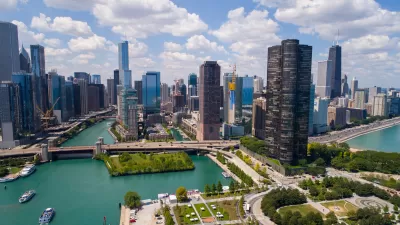From education to housing to health, Chicago's Gary Comer, billionaire founder of Lands' End, invested millions into the struggling South Side neighborhood of Pocket Town in a mission to transform it into a beacon of hope for the community.
Although it was never Gary Comer's intention to see the fruits of his labor in his lifetime, from one venture to the next, he's invested $86 million into projects aiming to improve Pocket Town, the neighborhood where he grew up in Chicago's South Side. Starting with a $68,000 check to fix an electrical problem at "the two-story red brick Paul Revere Elementary School," to investing $12 million in an affordable housing program, to setting up the Comer Science and Education Foundation, Comer made sure “he would take care of [the] neighborhood” long after his passing in 2006.
Elly Fishman writes, “Comer’s hugely ambitious quest contains elements of both the Kalamazoo Promise (a Michigan philanthropist’s pledge to pay for college for all local kids who graduate from public high school) and the Harlem Children’s Zone (an urban renewal program that provides an assortment of “cradle-to-career” services for children and families in New York City’s Harlem neighborhood). The plan he eventually hit upon was to address the interconnected problems facing Pocket Town’s residents: poorly performing schools as well as issues like substandard housing and inadequate health care.”
With all that said, Fishman asks, “What results has that huge investment yielded? And what lessons are there for policymakers, philanthropists, and everyone who cares about the fate of struggling urban neighborhoods?” Comer's initiatives have yielded successes, as well as failures. His health initiatives, for example, led to the vaccination of over 700 children this year. A youth center provides recreational activities, year-round jobs and 6,000 pounds of vegetables annually via a community garden. His housing and education activities have had mixed results.
"On paper," concludes Fishman, "$86 million looks like a helluva lot of money. 'But it’s really hard to change people and communities,” says [Harvard sociologist Robert Sampson]. “We need to be realistic. . . . The social forces that permeate the South Side don’t stop at the Pocket Town boundaries.”
FULL STORY: Can $86 Million Save a Neighborhood?

Pennsylvania Mall Conversion Bill Passes House
If passed, the bill would promote the adaptive reuse of defunct commercial buildings.

Planning for Accessibility: Proximity is More Important than Mobility
Accessibility-based planning minimizes the distance that people must travel to reach desired services and activities. Measured this way, increased density can provide more total benefits than increased speeds.

World's Largest Wildlife Overpass In the Works in Los Angeles County
Caltrans will soon close half of the 101 Freeway in order to continue construction of the Wallis Annenberg Wildlife Crossing near Agoura Hills in Los Angeles County.

New York Passes Housing Package Focused on New Development and Adaptive Reuse
The FY 2025 budget includes a new tax incentive, funding for affordable housing on state land, and support for adaptive reuse and ADUs.

LA Metro Board Approves New 710 Freeway Plan
The newest plan for the 710 corridor claims it will not displace any residents.

Austin’s Proposed EV Charging Rules Regulate Station Locations, Size
City planners say the new rules would ensure an efficient distribution of charging infrastructure across the city and prevent an overconcentration in residential areas.
City of Costa Mesa
Licking County
Barrett Planning Group LLC
HUD's Office of Policy Development and Research
Mpact Transit + Community
HUD's Office of Policy Development and Research
Tufts University, Department of Urban and Environmental Policy & Planning
City of Universal City TX
ULI Northwest Arkansas
Urban Design for Planners 1: Software Tools
This six-course series explores essential urban design concepts using open source software and equips planners with the tools they need to participate fully in the urban design process.
Planning for Universal Design
Learn the tools for implementing Universal Design in planning regulations.


























